Bringing Technology to Life [Part One]
If the SST project is about just one thing, it is about bringing technology into life, as distinct from make technology more life-like or invasive. We believe that sonic street technologies are exemplary in enhancing the creative powers and potentials of off-the-shelf electronic components, as well as those lovingly repurposed and customised. In many different ways and in different locations around the world, a variety of mobile apparatuses for playing recorded music illuminate how electronic equipment can be used to make a massively positive contribution to the lived experience – the livity as is said in Jamaica, or habitas as Bourdieu calls it – of what are often the most marginalised sectors of society. This is why the project is looking and listening to particular local sound system scenes to find the necessary evidence to answer the big questions about the relationship between technology and culture. Just as economic systems should be designed to serve the populace – rather than vice versa, as is so often the case – so technologies should be equally in the service of the community. This blog thus raises some of the key features of our approach to research through the research activities in which we’ve been engaged, to serve as our annual report for 2022.
SST Principles
Reporting back on the second of our five years provides us with a good point in which to take stock. The SST team has built substantially on the foundations laid in our first year; looking forward to 2023 also provides an opportunity to highlight some of the key principles of our research project – principles that are both political and theoretical, and which have become all-the-more apparent through progressing the research itself. The aim of Part One of this blog is to draw out these principles from the activities in which we’ve been engaged over the past twelve months; Part Two will explore our research methods, and although none of these principles are unique to SST, they serve to frame the values – and hopefully the value – of the project.
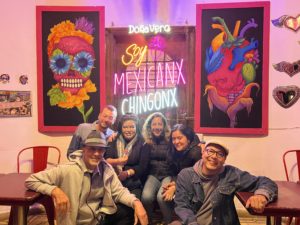
Figure 1 Some SST Mexico team members: Julian, Brian, Marisol, Yael, Linette and Cesar.
Research Collaboration
The first principle to highlight is the importance of collaboration. With only a small team at Goldsmiths, research on the project’s literally global scale could not proceed without the work of our collaborators, fellow researchers and SST practitioners, who are spread across the globe:
-
- Jamaica, Dr Sonjah Stanley-Niaah, Dr Dennis Howard, and Ashly Cork at the Institute of Caribbean Studies and the Reggae Studies Unit at the University of the West Indies, Mona, and Anthony Myers, chairperson, Jamaican Sound System Federation, with special mention to Garreth Daley and Rachael Bryan of our filmmaking partner GD Films
- France, Dr Jean-Christophe Sevin, Maria Emilia Escamilla, and Lucile Baleynaud at the University of Avignon
- Canada, Professor Mark Campbell, Safia Said and Alanna Stewart at the University of Toronto
- Colombia, Ricardo Vega, El Gran Latido sound system
- Brazil, Professor Liv Sovik at UFRJ, Dr Leo Vidigal at UFMG, Dr Marcus Ramusyo de Almeida Brasil at IFMA, Prof Fabio Abreu and Dr Thalisse Ramos de Sousa at UEMA; Daniella Pimenta, Andrea Lovesteady and Laylah Arruda of Feminine Hi-Fi.
- India, Dakta Dub from Bass Sanskriti and Monkey sound system and filmmaker Roy Dipankar of Royville Media
- Australia, Prof Douglas Kahn, and Dr Clare Cooper at the University of Sydney
- Portugal, Alpha Pup of Real Rockers, and Gustavo Pimeta Dias
- Mexico, Linette Rivera, Sebastian Perez Garcia, Ricardo Yep Yep Yep (Huesos gang), Marisol Mendoza (Musas Sonideras) and Dr César Rebolledo González at Universidad La Salle, with thanks to Moses Iten
- South Africa, Doc Inity of Kebra Ethiopia, and William Masemola
In the UK, the roll call of collaborators includes David Katz and June Reid in London and Mandeep Samra and Gopal Dutta working in Huddersfield, as well as Unit 137 sound system, based closeto Goldsmiths in Lewisham, and Sound System Outernational, the Goldsmiths research group that gave birth to the SST research project. We must also thank our social media partners Astarbene in Rome, Italy for their ongoing commitment to the project. Furthrmore, even this long list does not include our outernational cadre of bloggers.
During this last twelve months, the Goldsmiths SST team has expanded through the addition of Dr Natalie Hyacinth who right from her start in April has been making a major contribution to our research effort with her Lewisham case study, and with SSO #8, the UK Sound System gathering. We also suffered the very sad loss of our research manager, the late Charlotte Ayston-George. Therefore, since July, Dr Yael Gerson has continued the critical work of research management, bringing her own special skills and qualities to the job.
It has been evident throughout that what keeps this substantial workforce on mission is a shared enthusiasm for the SST project and our love of the music that the scenes propagate. This can be formulated as RESPECT x PASSION = GOOD VIBES. So, on this basis, together with our outernational team, we consider that the project’s achievements during this past year have been considerable.
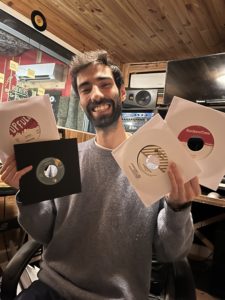
Figure 2 Alpha Pup, Real Rockers studio and sound system, Porto, Portugal, November 2022
Recognition and Respect
The second principle foundational for our approach – building on the first – is simply recognition and respect for the skills, practices, and knowledge systems of those who build and maintain not only SST equipment , but also the scenes in which such apparatuses are central. We are not in the business of extracting data. As a European Research Council (ERC)-funded project of our scale based in an internationally renowned research-intensive university in the Global North, we have a responsibility to make use of our social capital. It is comparatively easy to put this resource to good use, simply holding practitioner reasoning sessions inside a university, as most recently evidenced with SSO#8, held in November 2022 at Goldsmiths, described in Part Two of this blog;for many sound system owners, this was the first time that they had ever been invited into a university to talk about what they know and do.
Similarly, when the SST team travels abroad, making the effort to visit and to sit down and reason with practitioners in their studio, yard, or shop, it is often taken as a big encouragement for the practitioners to recognise their value as part of a global network as well as a local network. For the SST team, it is also important whenever possible to work through the local associations and networks so that each can add value to the other’s ongoing activities and projects. This is how we have been working with the Jamaican Sound System Federation and Feminine Hi Fi’s sound system mapping project, as well as with our social media partners the Astarbene collective, Unit 137 sound system, and the Alchemy music education project. As well as the headliners and big names on the scene, we must never forget the ordinary “foot soldiers of the culture” [1] who are keeping the scene alive in a matter-of-fact way, simply because it brings joy to their lives.
This principle of recognition and respect also extends to our collaborations with local researchers to once again use our social capital to add value to their research efforts. With our colleagues in the Global South, we have been working in Jamaica, Brazil, and India to date. Very often it is the case that the popular culture of the country, such as an SST scene, simply does not figure as a research subject area, as far as the university hierarchy is concerned. Consequently, much of the most interesting research takes place outside the academy, by journalists and enthusiasts, as in Mexico, for example. In this way, we are contributing to local research communities, helping to enact what we like to describe as amplifying strengths (or “building capacities” as development agencies call it). With our colleagues in the Global North, our collaborations can encourage their work with marginalised sections of their communities, as evidenced by our work with Canadian, American, and Australian universities.
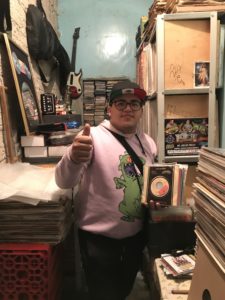
Figure 3 Guillermo Dasacu of sonido Memo Mix of Tepito market, CDMX, with part of the family’s record collection. With his love for vinyl, he describes himself as “and old person in a young body.”
Sharing Findings
Good research needs to be shared; this is our third principle. This is fundamental, given the living, the breathing SST scenes we investigate; and just as important for the practitioners and professionals who actually generate the knowledge systems we aim to be investigating. So, most important for this project is the audience of SST practitioners, afficionados and followers active on Instagram, Facebook and YouTube. In short, unless the project sustains the respect and support of the practitioners and the SST scenes, there will be no research findings to report to the academics.
The traditional academic researchers are of course also an important audience for the project, in what our ERC funders call the scientific outputs of the research. This is the readership of peer-reviewed journals and books and who are as likely to be found on Twitter as social media. The important point to make from our SST work so far is that the same research methods can be used to serve both audiences equally well, without compromise to either.
Sharing findings on social media helps to prevent the research from being extractive – that is, taking the findings from one place to another for processing. With the SST project, we have found that sharing findings can be one and the same process as originating those findings in the first place. This can be called research-in-community, examples of which are described in what follows. The basic idea is that practitioners discussing matters amongst each other in a shared space can provide deeper insights into their skills and knowledge systems than the conventional one-on-one researcher-subject ethnographic interview. Thus, the findings are shared at the very moment that they are found within the community of practitioners.
Practitioner Research Events
We have been developing ways of being party to practitioners sharing this knowledge between each other, as based on our commitment to the vital importance of practice-based-knowledge across all SST scenes. This comes in the form of reasoning sessions, as they are called in Jamaica, or on the other side of the world, yarnings in Australian Aboriginal communities. [2] Both involve discussion amongst peers based on respect and interests in common. A key element of our research methodology is staging such events and filming them. In several respects this continues the approach developed at SSO events staged over the years since 2017, but one important difference is that the SSO sessions involved researchers and practitioner participants in equal measure, whereas the current reasoning sessions consist of panels made up entirely of practitioners, with researchers amongst the audience.
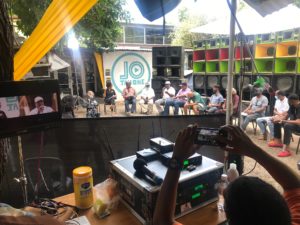
Figure 4 Sounds of the Future reasoning session, Kingston, Jamaica, February 2022
- Jamaica
Sounds of the Future, the first reasoning session that SST facilitated, was held in Kingston, Jamaica, in February 2022. The event gathered some of the leading figures of the island’s sound system industry, as well as a few younger practitioners active on up-and-coming sounds. The purpose was to ignite a discussion among peers about the current state of industry, the changes in technology, music, and business models, as well as the lack of institutional recognition and pressure from the police. Due to the size and scale of the panel, this was quite an ambitious operation, especially considering that the sound system scene in Jamaica is not easily accessible to outsiders. Therefore, we must also thank our local partners, the Jamaican Sound System Federation and the amazing UWI team, whose contribution was crucial for the successful outcome of the event.
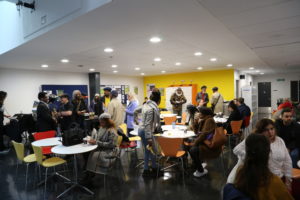
Figure 5 SSO#8 at Goldsmiths, November 2022
- UK
Supported by SST, Sound System Outernational’s eighth annual event, SSO#8 UK Sound System Reasoning Day took place at Goldsmiths, University of London on 5 November 2022, bringing together, for the first time, different generations of UK sound systems. Sound system practitioners that attended the event included King Earthquake from Birmingham, Young Warrior from Lewisham, Rebel Spirit Sound from Leeds, Sisters in Dub from Coventry, and Jah Youth from London, among many others. The day-long event was a brilliant, enlightening, and ground-breaking gathering from across English sound system generations, a coming together for much-needed reasoning and discussion of the current state of sound system culture in the nation. Some of the topics covered included the importance of Rastafari to the culture, the passing of knowledge from the elders to the younger generations in the scene, and potential ways in which to move the community positively forward.
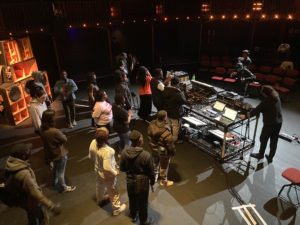
Figure 6 The launch of the Alchemy/ Unit 137 workshops at the Albany, Deptford, April 2022
- Alchemy music workshops
Another way of sharing findings has involved teaching workshops. Alchemy and SST, in association with Unit 137 sound system, Lewisham Borough of Culture and Sound System Outernational, thus embarked upon on a sound system learning programme in 2022. Beginning with the Sound System Masterclass in April 2022, the weekly programme has seen Alchemy students mentored by local Lewisham sound system, Unit 137, who have provided one-to-one sound system education, mentorship, and experience (as they had previously done with SSO in 2018).
The year’s learning programme culminated in a series of public performances for students to showcase their talents, starting with the Lewisham Sound System Trail in May 2022 and Lewisham People’s Day in July 2022. The events proved to be wonderful displays of young local creativity, which is often marginalised and largely overlooked, but powerful and important in understanding how SST can highlight and further inspire local community talent. We have commissioned Mikey Kirkpatrick, Alchemy founder and director to write a report reflecting upon the programme and its pedagogical importance. The learning programme, building on previous sound system educational work by Sound System Outernational, highlights the innovative connection between sound system culture and non-mainstream learning.
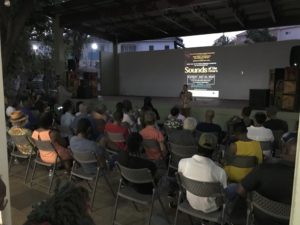
Figure 7 Screening Sounds of the Future at 10A, West Kings House Road, Kingston, July 2022
- Film Screenings
A further way in which we have been sharing our research findings has been through film screenings. One distinction between our approach and that of our sister organisation SSO is that the SST reasoning sessions have all been professionally filmed, which requires considerable organisational effort and cost, but ultimately makes the proceedings much more accessable as both complete documentaries and extracts for YouTube content. Additionally, the recorded audio testimony is transcribed for quotation and reference in the book chapters and journal articles that provide the research project’s academic outputs.
We made two documentary films this year. This first was Sounds of the Future: A Jamaican Sound System Reasoning Session, made from the five-hour discussion filmed with three cameras by the great GD Films. Working with editor Sherice Bromfield, this material became an inspiring 45 minute documentary. Sounds of the Future was then premiered in July at the 10A Kings House venue in Kingston as part of our effort to share project outputs with our research collaborators and participants in the first instance.
The second documentary was made from the filming of our Jamaican research interviews, rather than a reasoning session as such. Rockers Sound Station: Tales of the Kingston Dub Club is based around the renowned sound system owner and Dub Club proprietor Gabre Salassie. Rockers Sound Station was premiered in August at the Rototom Sunsplash festival in Spain as part of the Reggae University programme. Both film screenings have demonstrated the power of short movies to enable our research to engage with different audiences, as well as the appetite for more in-depth investigations into the music and culture among sound system aficionados.
All of the above only constitutes about half of the SST story for the year just gone, and next week’s blog will complete the picture.
References
[1] i As Brian D’Aquino remarked in discussion about the SST Lewisham research.
[2] Dean, Cheree. ”A yarning place in narrative histories”, History of Education Review, Vol. 39 No. 2, 2010, pp. 6-13. https://doi.org/10.1108/08198691201000005. Thanks to Dr Clare Cooper, an Australian SST colleague making us aware of these yarnings.
